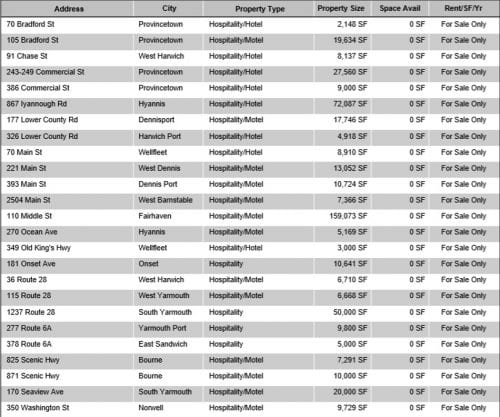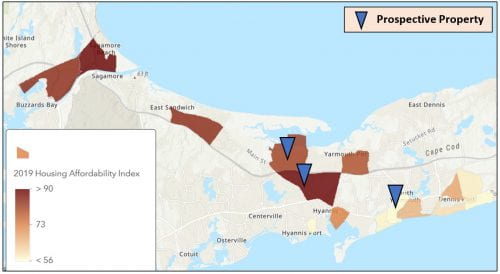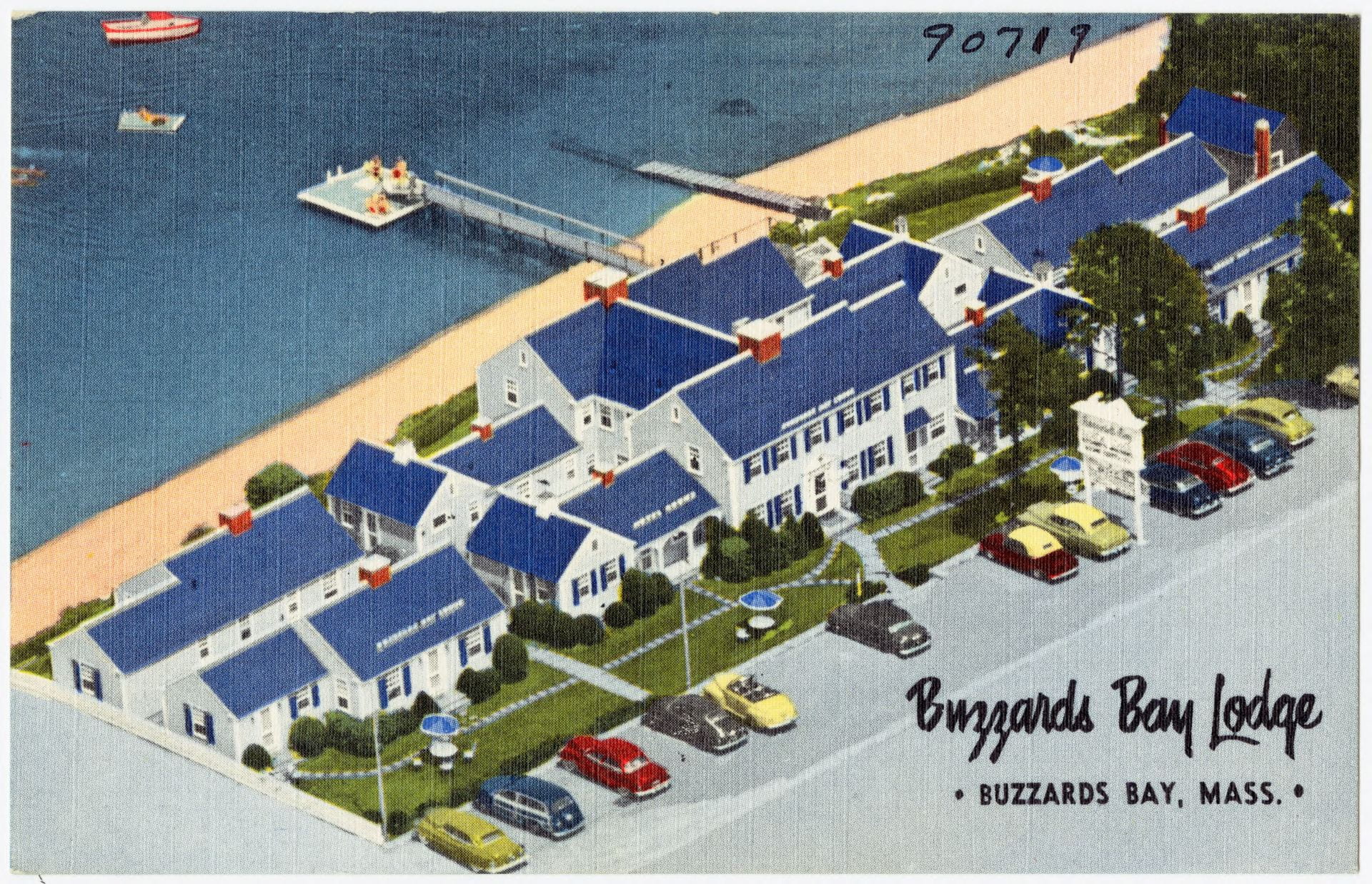
This article is a follow-up to an article posted last October that speculated about the viability of reusing distressed motel properties for various types of high-demand housing. In that article, various qualitative factors were laid out which could make certain properties easier to redevelop than others. It concluded that there would also be a mix of quantifiable factors that could be used to further distill available properties down to a handful of potential winners. This article will continue to support that argument with a method to select a handful of target properties from a list of current or recent motel listings. It focuses on the Cape Cod area of Massachusetts but can be scaled to any region and any number of targets.
Cape Cod, being a highly seasonal resort and vacation market, has a number of challenges when it comes to rental housing for year-round residents. The Housing Assistance Corporation of Cape Cod reported that in the five years preceding 2018, the Cape lost 3,000 year-round rentals and gained over 6,000 seasonal homes (Quinn & Coxe, 2018). The Cape is also home to a growing number of institutions for higher education, ranging from 4-year colleges, to satellite campuses of larger institutions, to technical colleges and trade schools. With the introduction of Bridgewater State’s Cape Cod campus in 2015, the total student population of such institutions is over 6,000 and continues to grow. Accommodations for such a diverse student and program mix is challenging in the midst of an already problematic housing environment. This study will focus on how public community college and university programs can reduce the cost of attendance by converting distressed motels into student housing, without exacerbating an area’s existing housing issues.
The Massachusetts State College Building Authority (MSCBA) finances and develops housing projects for public universities and colleges across the state. On Cape Cod, this includes Cape Cod Community College (4C), Bridgewater State University, and Massachusetts Maritime Academy (MMA). The two former institutions share many resources, with a recent example being the housing of 4C’s Aviation Maintenance students in Bridgewater’s facilities in Plymouth. The two schools are nearly adjacent to each other in the mid-Cape regions of Barnstable and Yarmouth, and these communities are also among the scarcest in terms of rental housing, with Barnstable’s rental and owned housing vacancy at only 1% (Town of Barnstable, 2016).
4C does not currently offer housing for its students on the Cape, and coupled with low housing inventory levels, this further exacerbates the issue of affordability as students compete with the local workforce for rentals. The school estimates $6,900 for housing expenses as part of its annual cost of attendance, well below the $7,900 average per unit income generated by MSCBA properties (MSCBA, 2019). This discrepancy helps to explain the lack of accommodations for students on Cape Cod, as the MSCBA can make more per unit elsewhere. The site identification program laid out in this article seeks to remedy that concern.
Methodology
Using the CoStar database, motel properties listed on Cape Cod were located and exported into an excel table.
From there, the information was uploaded into ArcGIS’s web-based GIS platform in order to plot the listings. In the same map, a shapefile was uploaded for the 2010 census block group data for Massachusetts and merged with the plotted motel listings.
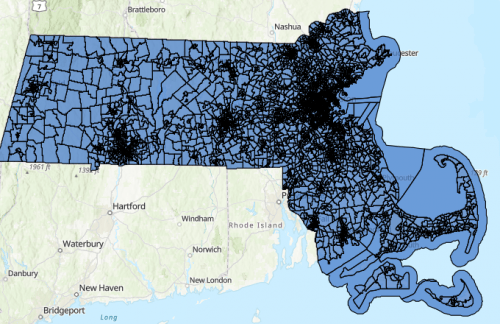
ArcGIS contains a trove of pre-loaded data for the United States from various sources like the US Census Bureau and ESRI, as well as an even larger database of user-hosted content. This data was used to select a range of relevant variables that would be useful in 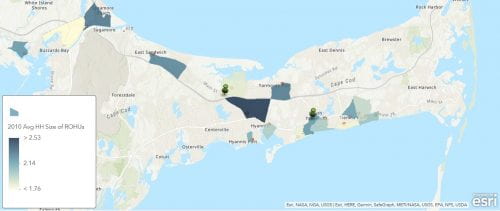 narrowing a field of target sites. Variables were chosen that ought to be negatively correlated with the typical student profile of either of the two colleges – Bridgewater State and 4C. This would have the effect of locating areas that are preferable to the year-round population of the Cape, and where students ought not to be competing for housing.
narrowing a field of target sites. Variables were chosen that ought to be negatively correlated with the typical student profile of either of the two colleges – Bridgewater State and 4C. This would have the effect of locating areas that are preferable to the year-round population of the Cape, and where students ought not to be competing for housing.
The map on the left depicts areas where there are larger average household sizes, which would indicate housing oriented towards families. The ideal census block group would skew towards smaller average household sizes, and those containing non-family households of only 1 person. These figures were plotted together on a separate map. 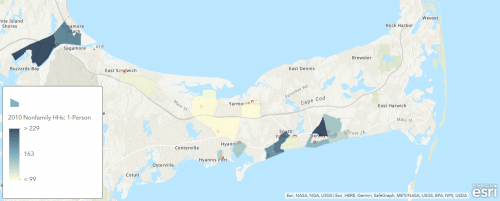
Predictably, where there is a low number of 1-person, non-family households, there tends to also be a high average household size in rental units. Also noteworthy is that in Buzzards Bay, where Massachusetts Maritime Academy is located (and where the MSCBA has built substantial cadet housing for individuals), there is the highest concentration of 1-person, non-family households within block groups that also contain listed motel properties.
Results
After multiple iterations of mapping these variables, merging the data, and eliminating properties that are located within undesirable block groups, this method was able to narrow the list to about 10% of its original size. The remaining properties, which can be automatically extracted from ArcGIS into an excel file, are determined to have high potential for student rental housing based on a combination of drive-time proximity to demand drivers and higher amounts of 1-person, non-family housing.
In this particular demonstration, one could have reached this conclusion by simply plotting the addresses of these colleges alongside the current listings and winnowing the field based on the resulting map. However, this would not be as straightforward at a larger scale. For instance, when searching for potential motel conversions at the state level – for public and private colleges and universities – a more systematic approach is warranted.
Using this method also has the dual benefit of identifying properties which could help provide for student housing without exacerbating the already bleak housing affordability problems on Cape Cod and beyond. The MSCBA, being a public institution, ought not to have a narrow focus when deciding where to house students enrolled in other public institutions like 4C and Bridgewater State, otherwise it will have damning effects on the efforts of state and regional housing agencies in the area.
Of the three properties that this method identified as potential winners, none are located in areas with a housing affordability index (HAI) greater than 100 (HAI greater than 100 indicates better housing affordability). Only one of the properties is in an area with a HAI greater than 90, and one is in an area with a HAI less than 50. The MSCBA might, therefore, be most successful providing student housing in areas where housing affordability is the most challenged. They would likely earn the support of regional housing agencies, who recognize the challenge of housing students and the community’s workforce in a low-vacancy environment, and they would earn the support of the community by reusing distressed properties in support of a growing local student population.
Without a doubt, converting motels to residential uses will encounter a number of non-trivial hurdles along the way. In the previous article, criteria were outlined which would make the physical redevelopment of such properties viable while minimizing construction costs, ensuring a development budget that agrees with its eventual rents. In this article, GIS analysis was used to show how aligning broad and narrow public interests could lead to a less cumbersome path through entitlement issues that might arise in the potential use-change. Developers can use these two methods together, along with a more traditional and fundamental analysis, relatively painlessly and at a very broad scale. The result will not upend multi-unit residential development as we know it, but it is certainly a market driven approach that works for all.
Works Cited
MSCBA. (2019). Annual Report – Fiscal Year 2019. Boston, MA: Massachusetts State College Building Authority.
Quinn, D., & Coxe, S. (2018). Housing on Cape Cod: The High Cost of Doing Nothing. Hyannis, MA: Housing Assistance Corporation.
Town of Barnstable. (2016). Housing Production Plan. Barnstable, MA: Town of Barnstable.
